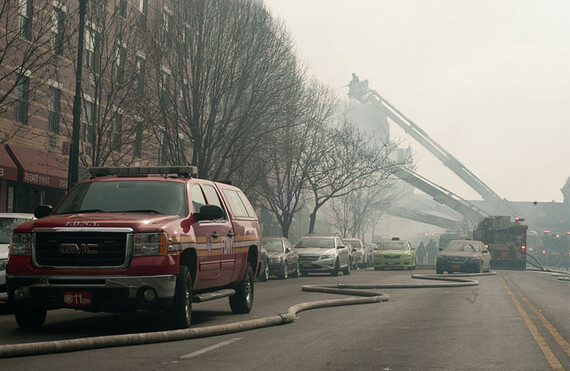Only when residents are empowered to become stewards of their environment can sustainability begin.
When I saw news of the recent building explosion in East Harlem, I was immediately transported to a sunny day six years ago. I was sitting on a tour boat on the East River with a visiting friend, listening to a voicemail from my husband telling me that our apartment building was on fire. I had no way of reaching him, since he was calling from a payphone, and no way of finding out exactly how bad things were.
The next day, as my neighbors and I sat in a nearby school cafeteria clutching our Red Cross bags and wearing borrowed clothes, first responders told us what kind of condition our building had been in when the top floor burst into flames. The building, we were told, had not been upgraded since 1928. In its investigation of the six-alarm fire that injured 23 firefighters and 25 residents, the FDNY found that the building's wires were copper, covered in threadbare fabric. Its pipes weren't even lead, but wrought iron so badly corroded that several inches of stagnant wastewater had pooled in our basement.
Yet according to the Department of Buildings website, the building had had no problems greater than the occasional elevator malfunction. Its inspection record was pristine.
The dozens of families living in that building were displaced for more than a year. Many had lived there for years and had no option but to wait out the renovations on someone's couch or in a homeless shelter—the rents in the neighborhood had essentially tripled in the preceding three years.
When I called the community board, I was told that this was not a matter of public concern, but a private issue to be resolved between individual tenants, their insurance companies, and a landlord who faced neither investigation nor litigation of any kind.
FROM CHAOS TO ACCOUNTABILITY
Today, I spend much of my time researching and discussing what makes cities resilient. One of the central questions of resilience is not just the ability to recover from disasters—like the building explosion in Harlem, which affected the entire neighborhood—but also the prevention of harm in the first place.
We know that growing populations and strained resources have resulted in deaths from informal or shoddy construction in booming cities throughout South America, Asia, and coastal Africa. But what about the apartment fires and gas leaks and sinkholes here in the ostensibly well managed Global North?
The fact is: Infrastructure needs maintenance. Buildings, no matter how solidly built, must be upgraded.
The gas main in Harlem is 127 years old. Aging natural gas mains in cities across the United States are severely prone to corrosion and leaks. American roads, bridges, pipelines, and electrical grids are old and in sore need of treatment. The problem, it seems, is determining when and how to upgrade aging infrastructure—who is responsible, and who will pay.
Clearly, if a building like mine was able to pass inspection with flying colors, we cannot count on the existing municipal bodies to keep our buildings safe.
Nor can we count on after-the-fact investigations to motivate us with shocking data. In fiscal year 2013 alone, the FDNY reported 493,377 fires, of which 7,012—1.4 percent—were investigated. Of these, the number one cause was found to be electrical, in 946 cases.
According to its website, the Bureau of Fire Investigations investigates "all complex, fatal and suspicious fires." But with such a low rate of investigation, one wonders what exactly constitutes "complex" and "suspicious." On the FDNY website, a visitor learns that one way to open an investigation into a fire is to file an incident report with the BFI. But if filing an incident report is a major impetus for an investigation, how aware are the city's residents of their power to do so?
Nor can we rely on individual companies, like real estate management firms and utility companies, to voluntarily cut into their profit margins to invest in construction upgrades.
So what needs to change? Infrastructure is not just a physical thing, it's also the lifeblood of a society, it's our connection with the environment. The Harlem explosion is felt far beyond the pile of rubble. It's felt in the power grid, the transportation system, and the community spirit.

Aerial view of the East Harlem building explosion. CREDIT: Adnan Islam (CC).
What we need is to reassess what we mean by community, and who has the responsibility to establish policies that govern that community, and what those policies will be.
Emerging thinking in resilience shows that true sustainability begins when communities are responsible for their own governance. The people who live in a place and use its resources are the best sources of information on how sufficient those resources are or how well they are functioning. Only when local residents are empowered to become "stewards" of their lived environment can they make the best use of this information.
When we learn that several people had noticed the smell of gas near the explosion sites in Harlem (a smell that indicated a problem), but only one resident called Con Edison 20 minutes before the explosion, we know that there is disengagement between the people and their infrastructure.
So where can we find the leverage to reconnect people with their built environments? The United States is no longer inclined to govern on a national level. The case for a new program modeled after the Works Progress Administration—which could boost our dismal employment stats—has foundered time and again. But cities and their mayors have tremendous executive powers. Now is the time for New York to take control of its aging infrastructure and set aside a fund for investing in and upgrading pipelines and buildings around the city. And it is the people of this city who should be demanding this action.
This important task should not be left in the hands of unmotivated private players who game the inadequate regulatory infrastructure at great cost to us.
Kavitha Rajagopalan is senior fellow at Carnegie Council and leads a project on urban resilience at World Policy Institute, where she is also a senior fellow.




